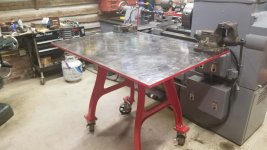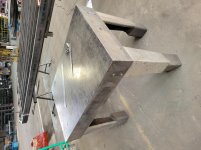Depends on what you are making.
I have a big 5' x 5' Acorn table, which is cast iron, and its great for bigger welding projects, and you can use clamps and holddowns all over it.
But I also have 3 steel fab tables- one, 24" x 144", for long things, and 2 that are about 36" x 72" and 36" x 96".
I find there are lots of times when welding something to a steel table is a great solution, and its very easy to grind off the weld.
I often use turnbuckles welded to pieces of round bar as corner braces, which allow you to dial in a corner of a large structure to 90 degrees quick and easy- and I have welded one end of a turnbuckle to a steel table literally hundreds of times.
The tables, after 25 years in the shop, are still just fine.
The problem I see is a solid cast iron table makes it hard to clamp things down in the middle.







